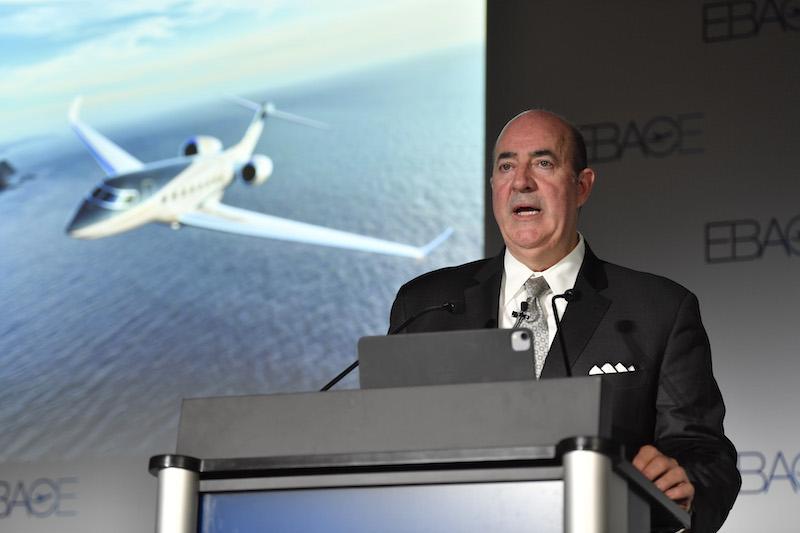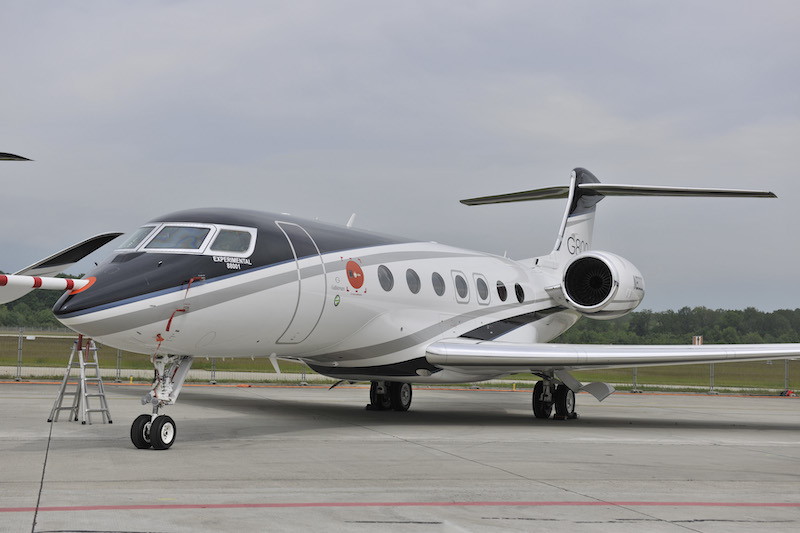
Mark Burns, Gulfstream's president, addresses the press at EBACE 2023.
GENEVA—Gulfstream Aerospace’s five G700 flight test aircraft are essentially finished with certification test flying, with FAA approval expected sometime this fall, depending on the FAA, officials say.
The market is strong for the G700 long-range business jet and the company is selling positions into late 2026, officials add.
“I think the market has held up at the higher end and been fairly resilient,” Mark Burns, Gulfstream Aerospace president, says during a media briefing on May 22, ahead of the opening of EBACE. “We sell G700s in just about every continent ... I feel good about where we’re at. I feel good about the interest level. We have a number of people who would like to move up in the order book.”
The ability to ramp up production, however, is related to supply-chain issues.
“We could go a little faster if we had the full support of the supply chain,” Burns says, adding: “There’s some issues that won’t allow it to move faster … When you get into this situation, you don’t want to go faster because you could jeopardize the quality of what we’re building if you’re trying to do things too much out of sequence. So, we prefer to keep a regular cadence as best as possible.”
The market remains strong, but it has evolved over the past two years from high-wealth individuals in the market for a G700 or G800 to more private business and corporate customers.
“We’re excited. The market is pretty stable, but it’s definitely slowed a little bit from immediate post-COVID,” Burns says. “But that was a little overheated in some way ... this is kind of more normal.”
In the meantime, the G700 has completed its flying qualities and aircraft performance flights with the FAA and has flown more than 4,000 flight hours.
“As far as our plan goes, we’re essentially done,” Burns says. “This is now up to the judge and jury [the FAA].
The aircraft’s performance has been outstanding, he says. “We’re excited about that. We’ll announce some of these findings very, very soon.”
The G700 has demonstrated “excellent” stability and control in takeoff, landing and climb during field performance and flight qualities trials over two months of testing at Cecil Airport in Jacksonville, Florida, Burns says. It completed water ingestion testing at NASA’s Wallops Flight Facility in Wallops Island, Virginia, with touchdown and taxi maneuvers in standing water at takeoff and landing speeds from 60 to 120 kt. In flyover noise testing, it displayed sound levels well below FAA regulations, the company reports.
In the meantime, the G700 has set 40 world speed records and completed a world tour flying 55,000 nm.
When it comes to FAA certification, “we are a little bit at the mercy of our regulators,” Burns says. “The airplane is the airplane. I think we’re essentially in the phase of now finishing up the FAA flying. We’ll do things like crew workload and type rating.”
Burns is hopeful that the G700 will receive FAA certification in the fall of 2023. “There’s a couple of things—and this will not be news to anybody because I have told them [the FAA] face-to-face—they’re under-resourced. They are not fully back in the office. They are working remotely mostly. It is a difficult process. I don’t think we’ve fully accounted for all the things that we’ve all been through with COVID, so it is taking much longer than I would have anticipated.”
In the meantime, Gulfstream’s G650 production line is currently building aircraft serial number 540. The G650 has continued to perform well, Burns says.
“We’ve had great success over the last couple of years with the G650,” but the G800 ultra-long-range business jet eventually will replace the G650. However, with the success of the G650, Gulfstream now plans to build the aircraft “quite a bit longer than we had planned.”
With the G800, Gulfstream’s plans call for only two flight-test aircraft for the program, since much of the “heavy lifting” for flight testing was completed on the G700.
“Things like flights into unknown icing and flammable fuel drainage, and all the difficult things you have to get through for testing an airplane, do not have to be repeated on the 800,” Burns says. Because of that, most of the testing will focus on control of the aircraft and field and flight performance.
Gulfstream estimates it will take 6-9 months after G700 certification is complete to finish G800 certification. Burns is hoping certification will be complete in early 2024.

The G800 is making its EBACE debut, with the flight of the first flight test article, which flew from Savannah, Georgia, to Geneva on a blend of sustainable aviation fuel.
The flight to Geneva demonstrates the maturity of the program, Burns says. “The G800 presents a compelling combination of high-speed aerodynamics and fuel-efficient engines to decrease emissions and save flying time for our customers.”
The G800 is powered by the Rolls-Royce Pearl 700 engine, which it shares with the G700, and a newly designed wing, also shared with the G700. It can fly 8,000 nm at Mach 085, and 7,000 nm at Mach 0.90. Its cabin can be configured with up to four living areas and seating for up to 19 passengers, with sleeping space for 10.
Following the G700 and G800, Gulfstream will move directly into work on the G400 large jet, the newest addition to the product line.
The G400 has been in the works since 2014, with plans to ramp up into production in 2024, Burns said.
Gulfstream continues to be hampered by supply-chain issues, which have evolved through the pandemic. When COVID hit the U.S., the market slowed and the supply base nearly slowed to a halt for a few months.
“Then as we restart, we want to go faster,” Burns says. “So, we tell suppliers: 'Not only do we want you to restart at the current level, we want you to go even faster.' We put a great deal of strain on the system as an industry. It was hard for them to catch up.”
Supply-chain issues have evolved from issues with electronics to adhesives and now to mechanical systems.
“I do think it is modestly improving,” Burns says. “I think we’ll struggle throughout the industry for the next six to nine months. I do see a level of commitment from the companies that we deal with to resource and have a forward-looking plan that allows us to increase our production rate, that we would like to do."
In a few cases, there is competition in the supply chain between production parts and spare parts.
Gulfstream had a significant stock of parts going into COVID, beyond “just-in-time” stock. “I think we weathered that storm a little better than most,” Burns says.
Every time there is a downturn, “it’s tires and windshields,” that are impacted, he says. “It seems like everybody consumes those on a daily basis. So those are the things that we were mindful of going in.”
Still, “I think we’ve weathered it better than most from a production standpoint,” he says. “We started to plan further out than we were. In some cases, we’ve pre-ordered inventory with suppliers for two years in advance to make sure that they feel comfortable as they ramp up their supply base, and their hiring that they have a long-term commitment.”
